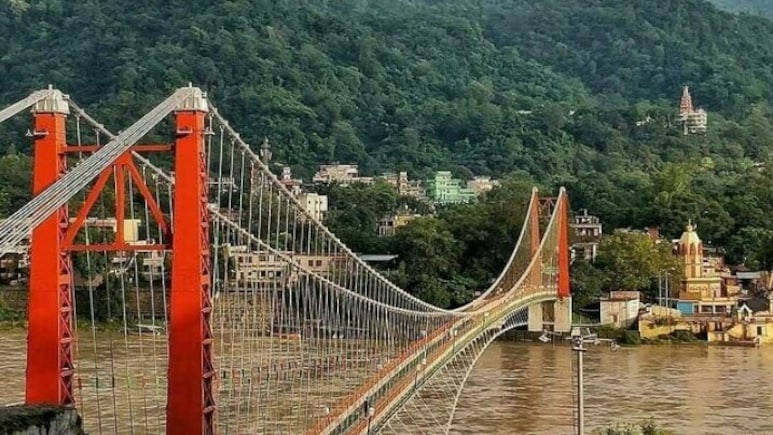
- Rishikesh will soon open Bajrang Setu, replacing the nearly century-old Lakshman Jhula bridge
- The new bridge features 1.5-metre-wide glass walkways offering views of the Ganga river below
- Bajrang Setu will improve connectivity and boost tourism, blending modern design with spiritual heritage
The iconic skyline of Rishikesh is set for a major transformation. The hill town, known globally as the yoga capital of the world, is preparing to open Bajrang Setu. This new suspension bridge will soon replace the nearly century-old Lakshman Jhula. The modern structure is designed to combine safety, aesthetics and accessibility - connecting the city's spiritual heritage with modern infrastructure. Officials told The Times of India that construction is almost complete, and the bridge is expected to open by the end of this year.
Bajrang Setu, Rishikesh will be ready soon After Lakshman Jhula, Ram Jhula and Jaanki Setu, Setu in the name of Bajrang Bali 🙏This is a glass bridge, on one side of which there is a figure of Kedarnath, and another side is Badrinath. जाय जाय बाजरंगबली . . . pic.twitter.com/FxAWKe02F7
— ExploreBharat (@ExploreBharat47) October 18, 2025
Disclaimer: NDTV does not vouch for the claims made in the X post.
A Century-Old Icon Nears Retirement
For locals and pilgrims, the replacement of Lakshman Jhula is bittersweet. Built in 1929, the iron suspension bridge stood for nearly a century as a symbol of faith, resilience, and spirituality. Mythology says that Lord Lakshman - brother of Lord Rama - once crossed the river Ganga at this very spot using a jute rope.
Over time, the bridge became one of Rishikesh's busiest and most photographed sites, connecting the Tapovan and Jonk villages and drawing everyone from sadhus to backpackers. However, structural assessments in recent years found it unsafe for traffic, prompting authorities to close it and begin work on a safer, modern alternative.
Bajrang Setu: Rishikesh's New Landmark
Estimated to cost around ₹60 crore, the new Bajrang Setu spans 132 metres in length and 8 metres in width, built with modern materials designed for both strength and aesthetics.
According to Praveen Karnwal, Executive Engineer of the Public Works Department's Narendra Nagar Division, "The construction of Bajrang Setu has been largely completed. About 90% of the work is done, and only the installation of glass on the pedestrian walkway remains. The bridge will be completed by December and is expected to be handed over to the administration early next year."
Also Read: The World's Tallest Bridge In China Has A Glass Cafe And Skywalk For Tourists
Glass Walkways And Ganga Views
One of Bajrang Setu's most striking features will be its glass walkways - 1.5 metres wide on both sides, made from 66-mm-thick reinforced glass panels. The transparent flooring will allow visitors to look straight down at the Ganga, adding a new dimension to Rishikesh's riverfront views.
The central section of the bridge will be reserved for two-wheelers, while the pedestrian walkways are being designed to handle high footfall safely. With its blend of modern design and mythological symbolism, Bajrang Setu is expected to redefine how travellers experience the holy town.
A Boost For Rishikesh Tourism
Tourism officials and local residents believe Bajrang Setu will significantly enhance Rishikesh's appeal - not just as a spiritual destination but as a visual one. The glass walkways, combined with panoramic river views, are expected to make it one of the most photographed spots in Uttarakhand once it opens.
Beyond the aesthetics, the bridge will improve connectivity between both sides of the Ganga, easing movement for pilgrims and visitors. Many hope this new structure will become as iconic as its predecessor - blending safety, faith, and spectacle in equal measure.
"When it opens, Bajrang Setu will not just connect two banks of the Ganga - it will connect Rishikesh's past with its future."
If You're Planning A Visit
Best time to visit Rishikesh:
October to March offers pleasant weather for sightseeing and yoga retreats. The summer months (April-June) are ideal for rafting, while the monsoon (July-September) paints the town lush green but can occasionally disrupt travel.
Quick weather guide:
- Winter (Nov-Feb): 8°C-20°C - Cool and clear, perfect for temples and treks.
- Summer (Apr-Jun): 25°C-38°C - Hot but good for water sports.
- Monsoon (Jul-Sep): 20°C-30°C - Scenic, with intermittent showers.
Also Read: From Spiti To Rishikesh: 11 Best Destinations In India For Experiencing Autumn
Top attractions nearby:
- Lakshman Jhula & Bajrang Setu: Old meets new across the Ganga.
- Triveni Ghat: Known for its evening Ganga Aarti.
- Parmarth Niketan: One of India's largest ashrams.
- Ram Jhula: Another iconic suspension bridge nearby.
- Neer Garh Waterfall: A serene nature spot for short hikes.
- Beatles Ashram: Famous for its murals and 1968 connection to The Beatles.
- Adventure activities: Rafting, bungee jumping, or yoga by the river.
Track Latest News Live on NDTV.com and get news updates from India and around the world

